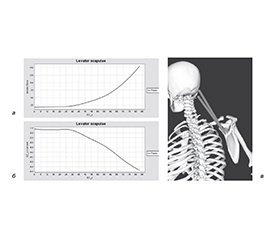Журнал «Травма» Том 26, №4, 2025
Вернуться к номеру
Моделювання роботи м’язів лопатки при згинанні верхньої кінцівки в плечовому суглобі
Авторы: Долгополов О.В. (1), Безрученко С.О. (1), Занько І.С. (1), Суворов В.Л. (1), Карпінська О.Д. (2), Карпінський М.Ю. (2)
(1) - ДУ «Інститут травматології та ортопедії НАМН України», м. Київ, Україна
(2) - ДУ «Інститут патології хребта та суглобів імені професора М.І. Ситенка НАМН України», м. Харків, Україна
Рубрики: Травматология и ортопедия
Разделы: Клинические исследования
Версия для печати
Актуальність. Лопатка і ключиця відіграють ключову роль у стабілізації та передачі навантажень від верхньої кінцівки до тулуба. Підняття руки передбачає рух як у гленоплечовому суглобі, так і в лопатково-грудному зчленуванні. При поєднаному пошкодженні структур цих суглобів порушується як цілісність кісткового кільця надпліччя, так і м’язово-зв’язковий баланс. Мета: визначити величину сили та крутних моментів, які створюють м’язи, відповідальні за стабілізацію лопатки та ключиці при згинанні руки. Матеріали та методи. Базова модель — тривимірна модель плеча та верхньої кінцівки для моделювання динаміки руки в реальному часі, включаючи незалежний м’язовий контроль лопатки та ключиці. Аналізували силу та крутний момент, які створюють м’язи, відповідальні за стабілізацію лопатки при згинанні (підйомі руки) вперед на 90°. Проводили аналіз роботи таких м’язів: mm. rhomboideus, trapezius scapularis та clavicularis, serratus anterior (upper), levator scapulae. Результати. Під час флексії плеча до 90° лопатка виконує латероротацію, підлаштовуючи свою позицію до руху плечової кістки. Це критично важливо для збереження підакроміального простору, запобігання імпінджменту й забезпечення плавного руху. Serratus anterior (lower) — головний ініціатор латероротації лопатки при флексії плеча. Його крутний момент найвищий у перших 20–30°, що критично для «розгону» руху. До 60° флексії активність serratus anterior (lower) є максимальною, саме тут формується найбільший крутний момент, як показує графік. Після 60°: функція стабілізації переходить до трапеції, serratus працює менш активно (ізометрично). Основна силова пара для стабільного руху лопатки при флексії складається з serratus anterior (lower) та trapezius (upper/lower), які забезпечують контрольовану латероротацію. Саме ці м’язи розвивають найбільші моменти при русі руки вперед — з serratus anterior (lower) на початку руху, trapezius (upper/lower) — при куті, близькому до 90°. Інші м’язи (rhomboideus, levator scapulae) модулюють і обмежують надмірні рухи, утримуючи лопатку стабільною. Висновки. За даними моделювання визначено, що основними м’язами-стабілізаторами лопатки при флексії плеча є serratus anterior (lower) і trapezius. Саме ці м’язи створюють максимальні крутні моменти при русі руки вперед. Через анатомічне положення цих м’язів — безпосереднє кріплення до найбільш рухомих ділянок лопатки — при переломі ці м’язи втрачають опору для створення моменту, що призводить до значного обмеження рухів верхньої кінцівки та порушення стабільності лопатки.
Background. The scapula and clavicle play a key role in stabilizing and transferring loads from the upper limb to the trunk. Raising the arm involves movement in the glenohumeral and scapulothoracic joints. With combined damage to the structures of these joints, both the integrity of the bony ring of the shoulder girdle and the muscle-ligamentous balance are disrupted. The purpose was to determine the magnitude of the force and torques created by the muscles responsible for stabilizing the scapula and clavicle during arm flexion. Materials and methods. The base model is a three-dimensional model of the shoulder and upper limb for simulating arm dynamics in real time, including independent muscle control of the scapula and clavicle. We have analyzed the force and torque created by the muscles responsible for stabilizing the scapula during flexion (raising the arm) forward by 90°. The work of the following muscles was evaluated: mm. rhomboideus, trapezius scapularis and clavicularis, serratus anterior (upper), levator scapulae. Results. During shoulder flexion to 90°, the scapula performs lateral rotation, adjusting its position to the movement of the humerus. This is critical to preserve the subacromial space, prevent impingement, and ensure smooth movement. Serratus anterior (lower) is the main initiator of scapular lateral rotation during shoulder flexion. Its torque is highest in the first 20–30°, which is critical for “acceleration” of the movement. Up to 60° of flexion, the activity of serratus anterior (lower) is maximal, this is where the greatest torque is generated, as shown in the graph. After 60°: the stabilization function passes to the trapezius, the serratus works less actively (isometrically). The main force pair for stable movement of the scapula during flexion consists of serratus anterior (lower) and trapezius (upper/lower), which provide controlled lateral rotation. It is these muscles that develop the greatest torques when the arm moves forward — with serratus anterior (lower) at the beginning of the movement, trapezius (upper/lower) at an angle close to 90°. Other muscles (rhomboideus, levator scapulae) modulate and limit excessive movements, keeping the scapula stable. Conclusions. According to the modeling data, it was determined that the main muscles that stabilize the scapula during shoulder flexion are serratus anterior (lower) and trapezius. They create maximum torques when the arm moves forward. Based on the anatomical position of these muscles — direct attachment to the most mobile areas of the scapula, with a fracture, they lose support for creating a moment, which leads to a significant limitation of upper limb movements and disruption of scapular stability.
плечовий суглоб; лопатка; згинання; м’язи; ізометрична сила; момент сили
shoulder joint; scapula; flexion; muscles; isometric force; moment of force

